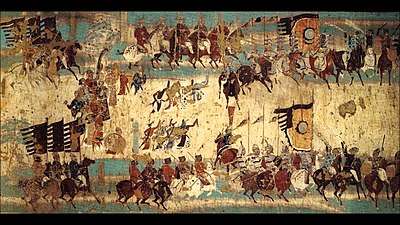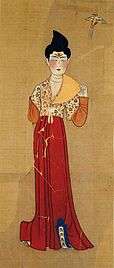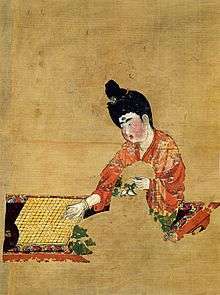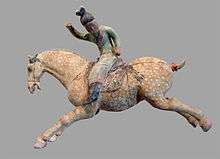Beiting Protectorate
The Beiting Protectorate-General, initially the Beiting Protectorate, was a Tang dynasty protectorate created in 702 to control the Beiting region north of Gaochang in contemporary Xinjiang.[1] Wu Zetian set up the Beiting Protectorate in Ting Prefecture (Jimsar County) and granted it governorship over Yi Prefecture (Hami) and Xi Prefecture (Gaochang). The Beiting Protectorate ended in 790 when Tingzhou was conquered by the Tibetan Empire. In 2014 the Beiting city ruins were designated a part of the Silk Road UNESCO World Heritage Sites.
| Beiting Protectorate(-General) | |||||||||
|---|---|---|---|---|---|---|---|---|---|
| Traditional Chinese | 北庭(大)都護府 | ||||||||
| Simplified Chinese | 北庭(大)都護府 | ||||||||
| Literal meaning | (Grand) Protectorate of the Northern Court | ||||||||
| |||||||||


Part of a series on the |
|---|
| History of Xinjiang |
 |
|
Medieval and early modern period |
History
In 702 Wu Zetian set up the Beiting Protectorate in Ting Prefecture (Jimsar County) and granted it governorship over Yi Prefecture (Hami) and Xi Prefecture (Gaochang).[2]
In 715 the Tibetan Empire attacked the Beiting Protectorate.[3]
In 735 the Türgesh attacked Ting Prefecture.[4]
In 755 the An Lushan Rebellion occurred and the Tang dynasty withdrew 200,000 soldiers from the Western Regions to protect the capital.[5]
In 764 the Tibetan Empire invaded the Hexi Corridor and conquered Liang Prefecture,[6] cutting off the Anxi and Beiting from the Tang dynasty. However the Anxi and Beiting protectorates were left relatively unmolested under the leadership of Guo Xin and Li Yuanzhong.[7]
In 780 Li Yuanzhong was officially made protectorate general of Beiting after sending secret messages to Emperor Dezong of Tang.[8]
In 781 the Tibetan Empire conquered Yi Prefecture.[9]
In 789 the monk Wukong passed through Ting Prefecture and found that the Chinese commander there was Yang Xigu.[10]
In 790 the Tibetan Empire conquered Ting Prefecture.[9]
In 792 the Tibetan Empire conquered Xi Prefecture.[9]
Post-Tibetan domination
In the immediate aftermath of the Tibetan conquest of Xi Prefecture, it was taken by the Uyghur Khaganate, after which the area became the border between the two empires.[11]
Zhang Yichao rebelled against Tibetan rule in Sha Prefecture (Dunhuang) in 848. In 850 he recaptured Yi Prefecture, in 851 Xi Prefecture, and in 866 Ting Prefecture. However he immediately lost Ting and Xi prefectures as well as Luntai (Ürümqi) to the Kingdom of Qocho. In 876 Yi Prefecture was also captured by the Kingdom of Qocho.
List of protector generals
- Zhang Song (張嵩) 722
- Ge Jiayun (蓋嘉運) 736
- Li Gong (李珙) 756
- Li Yuanzhong (李元忠) 780
- Yang Xigu (楊襲古) 789
Gallery
 Unearthed at the Astana Graves in 1972 from the tomb number 187. The background contains a bamboo plant. The image was to the right side of an image of a woman playing go. The tomb also contained a copy of the book "Tian Bao San Zai" dated to the year 744.
Unearthed at the Astana Graves in 1972 from the tomb number 187. The background contains a bamboo plant. The image was to the right side of an image of a woman playing go. The tomb also contained a copy of the book "Tian Bao San Zai" dated to the year 744. Unearthed at the Astana Graves in 1972 from the tomb of Zhang Lichen (655-702).
Unearthed at the Astana Graves in 1972 from the tomb of Zhang Lichen (655-702). Unearthed in 1972 from the tomb of Zhang Lichen (655-702).
Unearthed in 1972 from the tomb of Zhang Lichen (655-702). Unearthed at the Astana Graves from the tomb number 187
Unearthed at the Astana Graves from the tomb number 187 Unearthed at the Astana Graves from the tomb number 187
Unearthed at the Astana Graves from the tomb number 187 Unearthed at the Astana Graves from the tomb number 187
Unearthed at the Astana Graves from the tomb number 187 Unearthed at the Astana Graves in 1972 from the tomb number 187. The tomb also contained a copy of the book "Tian Bao San Zai" dated to the year 744.
Unearthed at the Astana Graves in 1972 from the tomb number 187. The tomb also contained a copy of the book "Tian Bao San Zai" dated to the year 744.
See also
References
Citations
- Drompp 2005, p. 104.
- Xiong 2008, p. 58.
- Wang 2013, p. 157.
- Bregel 2003, p. 19.
- Wang 2013, p. 167.
- Beckwith 1987, p. 149.
- "舊唐書". 中國哲學書電子化計劃. Retrieved August 3, 2017.
上元元年,河西軍鎮多為吐蕃所陷。有舊將李元忠守北庭,郭昕守安西府,二鎮與沙陀、回鶻相依,吐蕃久攻之不下。In the first year of the Shangyuan era [760], the Hexi Army Defense Command fell to the Tibetans. Beiting and Anxi were guarded by Li Yuanzhong and the old general Guo Xin, who along with the Shatuo and Uyghurs, were able to prevent the Tibetans from taking the two garrisons.
- "舊唐書". 中國哲學書電子化計劃. Retrieved August 3, 2017.
建中元年,元忠、昕遣使間道奏事,德宗嘉之,以元忠為北庭都護,昕為安西都護。In the first year of the Jianzhong era [780], Yuanzhong and Xin dispatched envoys through a remote path to memorialize the emperor. Dezong commended them and Yuanzhong became protector-general of Beiting while Xin became protector-general of Anxi.
- Bregel 2003, p. 21.
- "佛說十力經". Sutta Central. Retrieved September 4, 2017.
- Beckwith 1987, p. 156.
Sources
- Al-Sirafi, Abu Zayd (2014), Two Arabic Travel Books, New York University Press
- Algar, Ayla Esen (1992), The Dervish Lodge: Architecture, Art, and Sufism in Ottoman Turkey, University of California Press
- Asimov, M.S. (1998), History of civilizations of Central Asia Volume IV The age of achievement: A.D. 750 to the end of the fifteenth century Part One The historical, social and economic setting, UNESCO Publishing
- Azad, Arezou (2013), Sacred Landscape in Medieval Afghanistan: Revisiting the Faḍāʾil-i Balkh, OUP Oxford
- Barfield, Thomas (1989), The Perilous Frontier: Nomadic Empires and China, Basil Blackwell
- Beckwith, Christopher I (1987), The Tibetan Empire in Central Asia: A History of the Struggle for Great Power among Tibetans, Turks, Arabs, and Chinese during the Early Middle Ages, Princeton University Press
- Belyaev, Vladimir (2014), The coinage of Qara Khitay: a new evidence (on the reign title of the Western Liao Emperor Yelü Yilie), Russian Academy of Sciences
- Benson, Linda (1998), China's last Nomads: the history and culture of China's Kazaks, M.E. Sharpe
- Biran, Michal (2005), The Empire of the Qara Khitai in Eurasian History: Between China and the Islamic World, Cambridge University Press
- Borelova, Liliya M. (2002), Manchu Grammar, Brill
- Bosworth, Clifford Edmund (2000), The Age of Achievement: A.D. 750 to the End of the Fifteenth Century - Vol. 4, Part II : The Achievements (History of Civilizations of Central Asia), UNESCO Publishing
- Bregel, Yuri (2003), An Historical Atlas of Central Asia, Brill
- Bughra, Imin (1983), The history of East Turkestan, Istanbul: Istanbul publications
- Drompp, Michael Robert (2005), Tang China And The Collapse Of The Uighur Empire: A Documentary History, Brill
- Esposito, John L. (1999), The Oxford History of Islam, Oxford University Press
- Fiaschetti, Francesca (2014), Political Strategies of Identity Building in Non-Han Empires in China, Harrassowitz Verlag
- Golden, Peter B. (2011), Central Asia in World History, Oxford University Press
- Hansen, Valerie (2015), The Silk Road: A New History, Oxford University Press
- Haywood, John (1998), Historical Atlas of the Medieval World, AD 600-1492, Barnes & Noble
- Lapidus, Ira M. (2012), Islamic Societies to the Nineteenth Century: A Global History, Cambridge University Press
- Latourette, Kenneth Scott (1964), The Chinese, their history and culture, Volumes 1-2, Macmillan
- Levi, Scott Cameron (2010), Islamic Central Asia: An Anthology of Historical Sources, Indiana University Press
- Millward, James (2007), Eurasian Crossroads: A History of Xinjiang, Columbia University Press
- Moon, Krystyn (2005), Yellowface, Rutgers University Press
- Mote, Frederick W. (2003), Imperial China 900-1800, Harvard University Press
- Pavry, Bapsy (2015), The Heroines of Ancient Persia, Cambridge University Press
- Rong, Xinjiang (2013), Eighteen Lectures on Dunhuang, Brill
- Schluessel, Eric T. (2014), The World as Seen from Yarkand: Ghulām Muḥammad Khān's 1920s Chronicle Mā Tīṭayniŋ wā qiʿasi, NIHU Program Islamic Area Studies
- Sinor, Denis (1990), The Cambridge History of Early Inner Asia, Cambridge University Press, ISBN 978-0-521-24304-9
- Skaff, Jonathan Karam (2012), Sui-Tang China and Its Turko-Mongol Neighbors: Culture, Power, and Connections, 580-800 (Oxford Studies in Early Empires), Oxford University Press
- Soucek, Svat (2000), A History of Inner Asia, Cambridge University Press
- Takata, Tokio (2015), The Chinese Language in Turfan with a special focus on the Qieyun fragments, Institute for Research in Humanities, Kyoto University
- Thumb, Rian (2012), Modular History: Identity Maintenance before Uyghur Nationalism, The Association for Asian Studies, Inc. 2012
- Wang, Zhenping (2013), Tang China in Multi-Polar Asia: A History of Diplomacy and War, University of Hawaii Press
- Winchester, Bapsy Pavry Paulet Marchioness (1930), The Heroines of Ancient Persia: Stories Retold from the Shāhnāma of Firdausi. With Fourteen Illustrations, The University Press
- Wink, André (1997), Al-Hind the Making of the Indo-Islamic World: The Slave Kings and the Islamic Conquest : 11Th-13th Centuries, BRILL
- Wink, André (2002), Al-Hind: The Slavic Kings and the Islamic conquest, 11th-13th centuries, BRILL
- Xiong, Victor (2008), Historical Dictionary of Medieval China, United States of America: Scarecrow Press, Inc., ISBN 978-0810860537
- Xue, Zongzheng (薛宗正). (1992). Turkic peoples (突厥史). Beijing: 中国社会科学出版社. ISBN 978-7-5004-0432-3; OCLC 28622013
- Yakup, Abdurishid (2005), The Turfan Dialect of Uyghur, Otto Harrassowitz Verlag
- Yule, Henry (1915), Cathay and the Way Thither, Being a Collection of Medieval Notices of China, Asian Educational Services

.png)